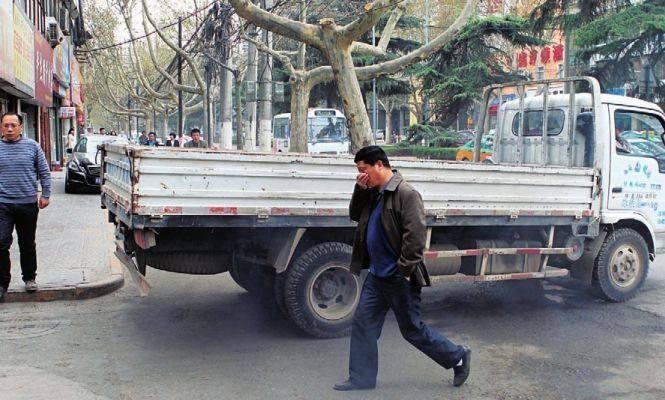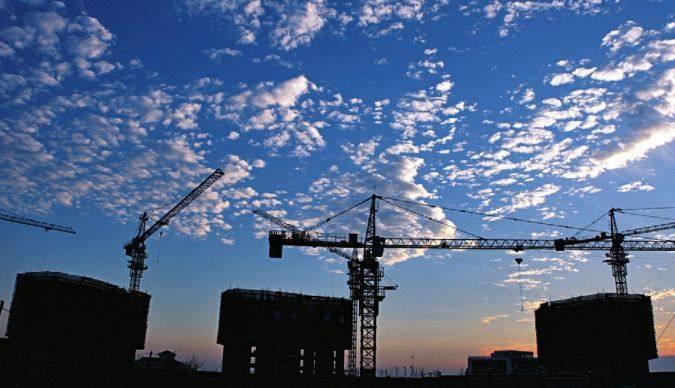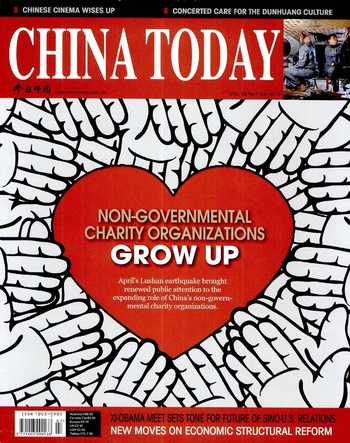Air Pollution Alert!
By staff reporter LI YUAN
W EN Xiangcai is on the staff of China National Environmental Monitoring Center. Her job is collecting and aggregating data, which is great for her – shes a scientist.
But in recent years Wen feels like shes turned into something of a media personality. She is asked questions on a variety of topics when she attends conferences, and she is often interviewed by journalists for her expert opinion.
As environmental consciousness has grown in China over the past few years, more and more people want to know what exactly is floating around in the countrys air.
There are a slew of measurements one can turn to in order to gauge the health of the environment. In China, however, air quality has become the goto measure.
Airborne particles smaller than 2.5 micrometers (PM 2.5), the most dam- aging to lung function of all particles, were officially included in the countrys air quality standard measurements in 2012. The 18th National Congress of the CPC held in March this year reiterated the idea that making China beautiful requires the governments determination in ecological conservation measures.
At the start of 2013 the future didnt look promising for the “Beautiful China”ideal. In fact, it didnt look anything at all – heavy smog in central and eastern China reduced visibility to a minimum. Pollution mask sales went through the roof. PM 2.5 measurements topped 700, which was unprecedented. In all, 74 cities in China reported very serious pollution in the months of January and February. Safe to say it was an awful time for many millions of Chinese.
Tracing the Source
Wen Xiangcai proposes some reasons for the Great Smog of 2013. Firstly, natural fog was unusually prominent earlier in the year. This exacerbated the situation dramatically. On the man-made side, increased electricity demands in winter for heating resulted in power plants burning greater quantities of coal. The number of private cars in cities continues to skyrocket; exhaust emissions are a big factor in city haze. Other,minor contributors to the smog include fireworks for the New Year celebrations and outdoor barbeques.
PM 2.5 is, by definition, too fine to see. But its presence in heavy smog is a serious health issue; by penetrating deep into the gas exchange regions of the lungs, high concentrations of PM 2.5 in the air pose health risks to young children, the elderly and anyone with breathing problems.
We know a lot about the effects of PM 2.5 on peoples health. But the actual source of the pollution has been a matter of dispute among scientists, says Wen Xiangcai.
The general consensus these days is that PM 2.5 results from primary particles (direct emissions from burning biomass, coal burning, exhaust emissions from vehicles, raised dust), and secondary particles formed in the chemical reactions of sulfur dioxide, nitric oxide, ammonia and volatile organic compound with gaseous pollutants in the air. The sources contribute to PM 2.5 in roughly equal measure.
To monitor PM 2.5 levels across the country, more than 400 automated monitoring stations have been set up in 74 cities. In addition, certain manual sample-collecting spots have been added. To provide even greater accuracy in assessment, a mobile monitoring vehicle has been used to compare air quality in different locations across inhabited locales.
“Environmental carrying capabilities are different from place to place. They are closely related to local natural environment, the size of population, and industrial distribution and enterprise structures,” said Wen Xiangcai.
Wen added that accurate analysis of pollution trends also provides an economic benefit to business. By providing local government with its data, her environmental agency can advise decision makers as to the viability and sustainability of proposed industrial projects. A more direct benefit from the extensive monitoring is locals being able to look to the web and check up on pollution on any given day. If readings are high, those with respiratory illnesses, for example, are advised to avoid strenuous outdoor activity. The situation is far from ideal, but measurement is the first step to finding solutions.
Wen Xiangcai and her colleagues regularly post the latest nationwide air monitoring data on their agencys website. Theyve also produced an app, which is a free download, so that those who arent necessarily in front of a computer can check pollution levels at any time.
Wen also added that the country used to rely on imported air monitoring equipment. This year, however, the central government has sought to spur domestic innovation in the field. In the future, China hopes to have its own, domestically developed scientific equipment to monitor PM 2.5.
Tackling Pollution
The heavy smog earlier this year may have been a blessing in elaborate disguise. If theres one good thing that came out of it, it is that the public grew extremely concerned over the quality of the air they breathe and health problems associated with it. Calls for action grew. People took their own measures to allay their concerns. Air purifiers sold like hotcakes across the country, and the price of special-purpose PM 2.5 facemasks soared.
Data from the Beijing Marketing Department of the Gome Electrical Appliances show that in the five days from January 25 to 29 Gome sold five times the number of air purifiers over the same period in 2012. Even its most expensive model, retailing for over RMB 3,000, flew off the shelves. Demand was such that when purifiers sold out, customers would purchase air conditioners with air purifying functions.
Online retails also did well out of the pollution scare. On taobao.com, Chinas go-to online shopping portal, sales of air purifiers so far this year are up 575.7 percent over the same period in 2012. On suning.com, a Taobao rival, air purifiers top the list of most commonly purchased items.
Wang Fang, vice chairman of Shanghai Indoor Contamination Control Industry Association (SICCA), cautioned buyers that air purifiers effectiveness in filtering out PM 2.5 depends on room size and concentration of PM 2.5 in the air. Bigger rooms require bigger filters, and settings should be continually adjusted in line with changing concentration of the matter. Even with an air purifier, staying up to date with the latest pollution readings is important. Perhaps even more importantly, the purifiers filter should be changed regularly –otherwise, the purifier itself can become a source of pollution.
Protective facemasks have been the other big seller this year. However not everyone has been convinced of the merits of wearing such a mask. Some main-tained fine particles make their way to the lungs no matter how good the mask in question. Again, the answer lies in regularly changing the masks filter. Disposable masks should be changed every day.
Facing heavy smog, city folks are displaying an increasing preference for trips to the suburbs, or even further to the mountains or seaside. For longerterm travel destinations, many are heading to “clean nature” spots, most of which are said to be in the south of the country. Real estate agents looking to cash in on the mania have started boasting about the clean air environments around houses as much as the houses themselves.
Some are taking a more holistic approach to fighting the pollution. Director of the Guangde Chinese Medicine Outpatient Department Ji Jie remarked,“According to TCM (Traditional Chinese Medicine) theories, we should adapt to the environment. In the short term, it is impossible to sculpt the environment to our will, so its best to improve our internal resistance – our immune system – to cope with the challenge.”

Fighting Smog at Source
When it comes to actually ridding the environment of smog, tackling harmful pollutants at their source is key.
Wen Xiangcai pointed out that since the aerosphere is an inherently dynamic system, localized purifying methods would not solve the issue entirely. Controlling emissions in the first place should be a priority. China has been busy learning from foreign experiences and set up regional joint control systems to ensure pollution-tackling measures are comprehensive. The 13 key regions in the initiative include the BeijingTianjin-Hebei region, the Yangtze River Delta, the Pearl River Delta, and city agglomeration in central Liaoning Province, the Shandong Peninsula, and Wuhan (capital of Hubei Province) and its environs. At the end of 2012, the 12th Five-year Plan on preventing air pollution demanded that the 47 cities covering 14 percent of the total territory of China reduce PM 2.5 levels 5 percent by 2015.
Recently, Chinas National Development and Reform Commission (NDRC) proposed a plan to set a cap on the countrys greenhouse emissions. The proposal still needs to be accepted by Chinas State Council. Once adopted, the country will set out to reduce absolute emissions of CO2. Currently the country has pledged to cut its “carbon intensity”– the amount of CO2 produced per RMB 10,000 of economic output – by about 40 percent over 2005 levels by 2020.
Tackling pollution has required tangible government action, but ordinary people and non-governmental organizations can help as well. The smog earlier this year spurred many to act.
Recently an international seminar series on “eco-civilization” development and Gross Ecosystem Product (GEP) was jointly initiated by the International Union for Conservation of Nature(IUCN), the Elion Green Foundation and Beijing Normal University. The GEP is the brainchild of the IUCN and aims to set up an analytic and accounting system to include the eco-environment in GDP measures. It incorporates the gross value of the production of forests, deserts, wetlands and artificial ecosystems of farmland, pasture and aquafarms of a given country into wealth and income measures.
President of IUCN Zhang Xinsheng remarked that the GEP accounting project is helpful in assessing the status of an ecosystem in a scientific and feasible way, and is a stepping-stone to further integration of ecological measures with national economic statistics.
Beijing is one of the cities most seriously afflicted by the smog this year. In response, the municipal government has implemented a series of clean air measures for 2013. Sixty-nine initiatives were listed to improve air quality, ranging from macro-measures like shutting down the heaviest polluters and encouraging conversion to clean energy, to micro-measures like tightening restrictions on smoke from barbeque restaurants and chemical emissions from drycleaners.
Beijing will also remove 180,000 old, high-polluting motor vehicles from its roads, set aside an additional 350,000 mu (15 mu = one hectare) of land for afforestation efforts, reduce emissions of hazardous organic compounds by 5,000 tons and ensure local coal burning does not exceed 21.5 million tons in volume.
“The environmental issues facing China have also confronted other countries in their economic development. When we see a problem, we have to face it calmly,” Wen Xiangcai said.
“The environment is so important – it influences everyone and every industry. Eliminating high-polluting production methods and lifestyles and carrying out economic activities with an eye to environmental sustainability is important both now and for our descendants,” Wen concluded.

